
Abstract
The term "forklift license" is a colloquialism frequently used to describe a professional credential that is, by U.S. federal regulation, actually a forklift certification. This technical article provides a comprehensive, step-by-step guide to achieving the federally-mandated operator status for Powered Industrial Trucks (PITs), as outlined by the Occupational Safety and Health Administration (OSHA) standard 29 CFR 1910.178(l). We will clarify the critical distinction between a government-issued license and an employer-issued certification, detail the required three-part training process (formal instruction, practical training, and final evaluation), and analyze the roles of the operator, the employer, and the qualified trainer in achieving and maintaining compliance. The application process is not an external bureaucratic submission but an internal, workplace-specific system of documented competency.
1. Defining the Credential: Certification vs. License
A precise understanding of the required credential is the foundational step for any aspiring operator.

1.1 The Absence of a "Forklift License"
In the context of workplace safety within the United States, there is no separate, government-issued "forklift license" analogous to a state-issued driver's license. The state-issued driver's license is concerned with operating a motor vehicle on public roadways; it does not fulfill the requirements for operating a Powered Industrial Truck in a private or commercial work environment.
1.2 The Mandate for Forklift Certification
The required credential is a Forklift Certification. This is a document of competency issued and maintained by the employer.
Feature Forklift Certification (Required) Driver's License (Not Applicable)
Issued By The Operator's Employer State Department of Motor Vehicles (DMV)
Legal Basis OSHA Standard 29 CFR 1910.178(l) State/Federal Motor Vehicle Codes
Focus Safe equipment operation within a specific workplace Safe vehicle operation on public roads
Content Stability triangle, load center, site-specific hazards Road laws, traffic signs, general vehicle control
Validity Maximum of three years (requires re-evaluation) Varies by state (typically 4-8 years)
The entire "application process" for this certification is the act of successfully completing the employer's OSHA-compliant training and evaluation program.
2. Prerequisites for Certification
Before an individual can begin the process of application through training, two fundamental prerequisites must be met.
2.1 Minimum Age Requirement
Per the Fair Labor Standards Act (FLSA), specifically the Hazardous Occupations Order No. 7, an individual must be at least 18 years old to legally operate a Powered Industrial Truck (PIT) in non-agricultural settings. No training or certification is valid for a minor.
2.2 Employer Sponsorship
The certification process is inherently tied to a place of employment. While an individual can complete the formal instruction (the "classroom" portion) independently through third-party online or vocational courses, the final, mandatory certification step—the practical evaluation—must be performed by the operator's current or prospective employer who has the authority and responsibility for their safety in the workplace.
3. The Three-Phase Application Process (Training and Evaluation)
OSHA Standard 29 CFR 1910.178(l) outlines a mandatory, three-part training system that serves as the official "application" for certification. This process must be conducted by a "qualified person"—an individual who, by possession of a recognized degree, certificate, professional standing, or who by extensive knowledge, training, and experience, has successfully demonstrated their ability to train and evaluate PIT operators.
Phase 1: Formal Instruction (Theoretical Knowledge)
This is the "classroom" portion, which can be completed via lecture, video, online modules, or a combination thereof. The technical content must cover:
Category Key Topics (OSHA Requirements)
Equipment-Specific Operating instructions, warnings, and precautions for the type of truck (e.g., counterbalance, narrow aisle, reach). Controls and instrumentation. Engine/motor operation and refueling/recharging procedures.
Operational Dynamics Differences between the truck and an automobile (e.g., rear-wheel steering, stability). Visibility (including load obstructions). Fork and attachment adaptation, operation, and use limitations.
Safety & Inspection Principles of vehicle stability (the stability triangle and center of gravity). Mandatory pre-shift inspection procedures. Safe parking and shut-down protocols.
Application Action: Enroll in a reputable training program (internal or third-party) and pass the corresponding written or online knowledge test. This results in a Certificate of Completion for the formal instruction.

Phase 2: Practical Training (Hands-on Demonstration)
This component involves supervised, hands-on operation of the PIT in the actual work environment. It bridges the theoretical knowledge to real-world application.
Trainer Demonstration: The qualified trainer first demonstrates the correct procedures, including pre-shift inspections, mounting/dismounting, and all operational maneuvers.
Trainee Practice: The trainee then performs practical exercises, operating the truck in a controlled environment under direct supervision. Trainees are only permitted to operate the PIT during this phase and only where the operation does not endanger the trainee or other employees.
Application Action: Actively participate in the demonstration and exercises. Practice maneuvering, load handling, and navigating the workplace environment under the trainer's instruction until a fundamental level of operational skill is achieved.
Phase 3: Performance Evaluation (The Final Certification Step)
This is the ultimate "application" checkpoint. The qualified person must formally observe the operator performing all job functions on the specific equipment they will be using in the specific workplace where they will be working.
Evaluation Area Technical Competency Requirement
Pre-Operation Executes a complete and documented pre-shift inspection (e.g., tires, horn, hydraulic function, battery level) and identifies any defects.
Traveling Maintains safe speeds, controls stopping distance, uses horn correctly, and adheres to load clearance rules (3 truck lengths rule of thumb).
Load Handling Approaches load correctly, centers forks, tilts mast appropriately, lifts load to correct height, and stacks/unstacks safely.
Site-Specific Safely navigates ramps, docks, railcars, pedestrian aisles, and highly-congested areas specific to the worksite.
Shutdown Parks the PIT in an authorized location, lowers the forks fully, neutralizes controls, sets the parking brake, and shuts off the power.
Application Action: The operator must successfully pass this final evaluation to the satisfaction of the qualified person. The act of the employer documenting and signing off on this successful evaluation constitutes the issuance of the Forklift Certification.
4. Documentation and the Operator Card
The true "application" record for a forklift certification is the documentation retained by the employer.
4.1 Certification Records
OSHA mandates that the employer must maintain a record of the certification, which must include:
Name of the certified operator.
Date of the training.
Date of the evaluation.
Name of the person(s) performing the training or evaluation.
This documentation is the evidence that the operator is legally compliant.
4.2 The Operator's Wallet Card
While not legally mandated by OSHA, nearly all compliant training programs and employers issue a small, durable wallet-sized card (often referred to as the "forklift license"). This card serves as convenient, immediate proof that the operator has successfully completed the certification process.
The card should include:
Operator's name and photo (optional, but common).
The effective date of training and expiration date (3 years later).
A list or indication of the types/classes of PIT the operator is authorized to operate.
The name of the issuing company/employer.
5. Recertification: Maintaining the Credential
The "license" is not permanent. The operator must maintain competency, which requires mandatory re-evaluation.
5.1 The Three-Year Rule
The certification is valid for a maximum of three years. At the end of this period, the employer must conduct a mandatory re-evaluation of the operator's performance to ensure their skills remain adequate. If the evaluation is successful, the operator is recertified for another three years.
5.2 Mandatory Retraining Triggers
Retraining (a full or partial repetition of Phases 1 and 2) and re-evaluation are required at any time the operator:
Is involved in an accident or a "near-miss" incident.
Is observed operating the truck in an unsafe manner.
Is assigned to operate a different type of PIT.
Encounters a change in workplace conditions (e.g., new racking, different pedestrian traffic patterns) that affects safe operation.
6. Summary of the "Application" Flowchart
The process of "applying" for a forklift license can be simplified into a clear, linear flow:
Step Action Responsibility Resulting Document
1. Meet Prerequisites Be 18 years of age or older. Operator FLSA Compliance
2. Formal Instruction Enroll in an OSHA-compliant course (online or classroom) and pass the knowledge exam. Operator/Training Provider Certificate of Completion
3. Practical Training Receive hands-on, supervised training on the specific equipment. Employer/Qualified Trainer Practical Training Log
4. Performance Evaluation Demonstrate safe and competent operation of the PIT in the actual workplace. Employer/Qualified Trainer Signed Evaluation Checklist
5. Certification Issuance Employer formally documents the successful completion of all three phases. Employer Official Forklift Certification (and wallet card)
6. Maintenance Be re-evaluated every three years, or after a specific incident/change. Employer Updated Certification Record
The application for a forklift license is thus an intrinsic part of the employment process, a dedication to safety where the employer acts as the certifying authority, validating the operator's technical competency under federal law.
Name: selena
Mobile:+86-13176910558
Tel:+86-0535-2090977
Whatsapp:8613181602336
Email:vip@mingyuforklift.com
Add:Xiaqiu Town, Laizhou, Yantai City, Shandong Province, China